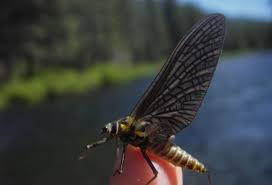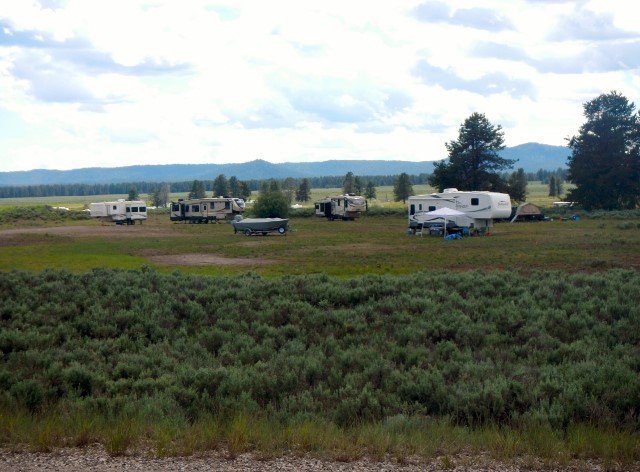Flow out of island Park Reservoir was upped to about 1700 cfs a week ago with decreasing discolor in the water. Normal flow for this date is around 1100 cfs. The current flow has placed somewhat of a damper on the top water fishing (there is plenty of food at depth, so no need for fish to expend energy to go to the top for it) in the Last Chance to Pinehaven section, but the mayflies are still active. Nymph patterns work best in Box Canyon. Flow is up in the lower river, but especially below Ashton Dam it has warmed to the point that early AM and evenings are the best times for fishing success. Because of our unusually hot, dry summer expect that flows will stay high as long as irrigation demand is present and the system can deliver water.
We place much of the Henry’s Fork Foundation’s Rob Van Kirk’s July 13th Henry’s Fork watershed information on our report. This because because Rob’s work offers much that explains reasons for the current water situation and what to expect with respect to fishing conditions on major streams within. See below.
Headlines:
- Yesterday was the warmest day of the summer so far, and water-year precipitation to date dropped to 75% of average.
- Natural streamflow and diversion continue to stay relatively constant over the watershed, although diversion has been changing one way or the other at several canals on a daily basis.
- At an outflow of 1472 cfs, Island Park Reservoir is 65% full, compared with 85% on average and 61% in 2016.
- Turbidity in the Henry’s Fork between Island Park and Ashton has improved substantially in the last few days. See water quality section at the bottom of the report.
Details:
At 7 degrees F above average, yesterday’s mean temperature edged out June 15 as the warmest so far this summer. Mean temperature yesterday was the warmest since August 17 of last year, and the maximum was the warmest since last September 5. No precipitation was recorded, dropping the water year total to 75% of average. Afternoon high temperatures will drop a degree or two over the next few days, due in part to smoke cover. A few showers are possible over Island Park and the Yellowstone Plateau.
Natural flow continues to drop very slowly and is staying in the neighborhood of 57% of average for the watershed: 75% of average at Island Park, 89% of average for the upper Henry’s Fork subwatershed as a whole, 50% of average in Fall River, and 25% of average in Teton River. Total natural flow for the water year to date is 78% of average. Diversion has also stayed relatively constant at around 96% of average over the watershed. However, individual canals have made changes on the order of 50-150 cfs one way or the other over the past few days. Total diversion for the irrigation year to date is 99% of average. Crosscut Canal delivery to the Teton River has been fairly constant at around 375 cfs for the past three days. Streamflow in the lower Henry’s Fork has been stable for the past 48 hours within 75 cfs of target flows.
At an outflow of 1472 cfs yesterday, Island Park Reservoir dropped by 1965 ac-ft yesterday and is 65% full, compared with 85% full on average and 61% full in 2016. Total storage in the watershed’s three reservoirs is dropping at 2200 ac-ft/day. The three-reservoir system currently at 73% of capacity, compared with 83% on average and 70% in 2016.
Water quality:
Turbidity has decreased substantially in the Henry’s Fork between Island Park and Ashton. Turbidity at the dam gates has decreased from around 13 turbidity units (FNU) in mid-June when the gates were first opened substantially for the first time this year to around 5 FNU now. On the power-plant side of the dam, turbidity dropped from a high of 5 FNU two weeks ago to around 2.5 FNU today. Turbidity on the power-plant side of the dam was below average yesterday for the first time in a month.
Turbidity over the past month has been caused primarily by delivery of fine sediment from the reservoir bottom, as we have seen little evidence of algae or other phytoplankton production in the reservoir over that time period. Most likely, the reason for the recent decrease in sediment delivery is because sediment deposited behind the dam gates from last September’s wind-driven “sloshing event” has now been moved out of the area behind the gates due to a few weeks of high outflow through the gates. Had water-supply conditions allowed delivery of a high spring freshet flow—as occurred in 2018, 2019, and 2020, most of that sediment would have been moved out during April or May. Until irrigation demand necessitated reservoir outflow in excess of power plant capacity back in mid-June, the gates had remained closed since the beginning of August of last year, allowing sediment to accumulate there for over 10 months.
Turbidity at Pinehaven has dropped from around 8 FNU to 4 FNU and is now right at average after spending around 8 weeks above average. Similarly, turbidity at Marysville has dropped over the past several days from 5-6 FNU back down to its long-term average of 2.5 FNU. At these locations, the drop in turbidity is due in part to decreased sediment delivery at the dam and in part to increased aquatic vegetation growth in the river between Island Park and Pinehaven, which traps fine sediment as it moves through the reach.
As a result of above-average air temperatures and sunny weather, water temperatures have been above average across the watershed since the end of the cool, rainy spell we had at the end of May. However, temperatures have generally remained in the optimal range for trout—roughly 55-67 degrees F at all of our sonde locations except Pinehaven, St. Anthony, and Parker-Salem (Red Road bridge). Water temperatures have regularly exceeded 70 degrees at Pinehaven and St. Anthony during late afternoon and evening—from 1 p.m. to midnight on most days. Maximum temperatures have reached as high as 73 degrees at Pinehaven and 76 degrees at St. Anthony. Water temperature at Parker-Salem is cooling below 70 degrees only for a few hours in the morning, and we recorded maximum temperatures exceeding 80 degrees for about 10 days at the end of June and beginning of July. Although no fishing restrictions are in place as a result of high water temperatures, please be aware of these stressfully high water temperatures and fish responsibly.
Fortunately, dissolved oxygen levels remain good throughout the watershed, due to a combination of factors that include photosynthesis by aquatic vegetation and turbulent flow at the Island Park Dam gates, through canyon reaches, and over lava flows and irrigation dams in the lower watershed.
Rob Van Kirk, Ph.D.
Senior Scientist
Henry’s Fork Foundation
P.O. Box 550
Ashton, ID 83420
208-652-3567 OFFICE
208-881-3407 CELL
208-652-3568 FAX


